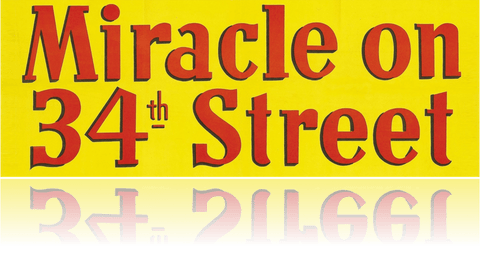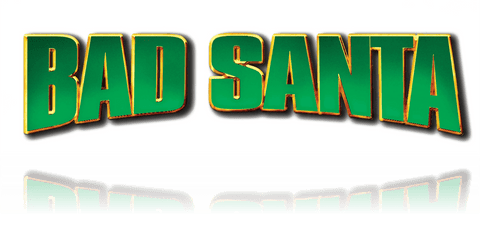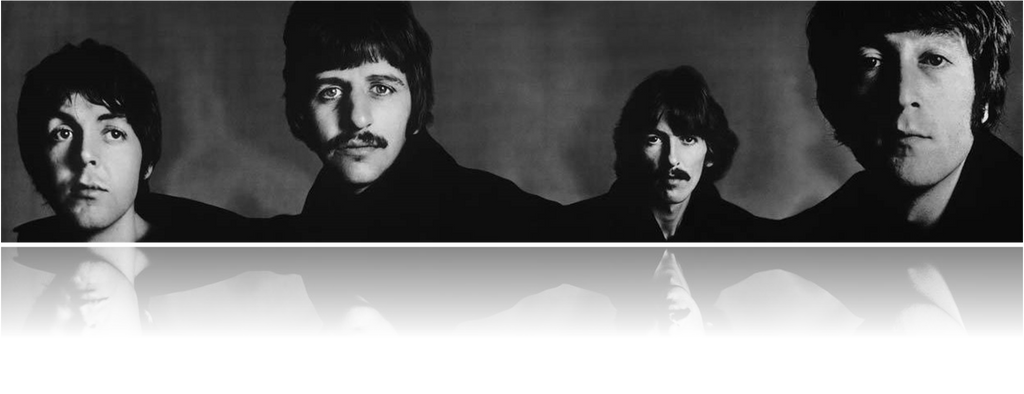
Formed in Liverpool in 1960, by the time of their break-up, only a decade later, ‘The Beatles’ had changed the face of popular music forever.
Those ten frenetic years saw the production of twelve ground-breaking albums (five of which won the “Album of the Year” Grammy), three-hundred and five songs (of which seventeen reached number one in the U.K.) and five films (two of which were Oscar nominated).
By anyone’s standards, that is an incredible workload and an astonishing level of quality to maintain. The resulting stresses and strains must have contributed to the band’s acrimonious split in 1970.
However, nearly fifty years later, The Beatles are as iconic as ever. The cultural legacy they left behind surrounds us today.
The Beatles cinematic career spanned 1964 – 1970, with four films made for cinema, and a further one made for television. It is perhaps, one of the most overlooked parts of this phenomenal group's creative output.
Below, we take a quick look at each one of these remarkable films.

A Hard Day’s Night (1964)
On the 5th October 1962, The Beatles released their first single Love Me Do. When filming for A Hard Day’s Night began, only sixteen months has passed, but they had already produced Britain’s first million selling album and made their landmark U.S. TV appearance on The Ed Sullivan Show.
From the opening guitar chord "twang” of the title track, A Hard Day’s Night sets out its stall, a comedic, exaggerated, take on ‘a day in the life’ of a Beatle.
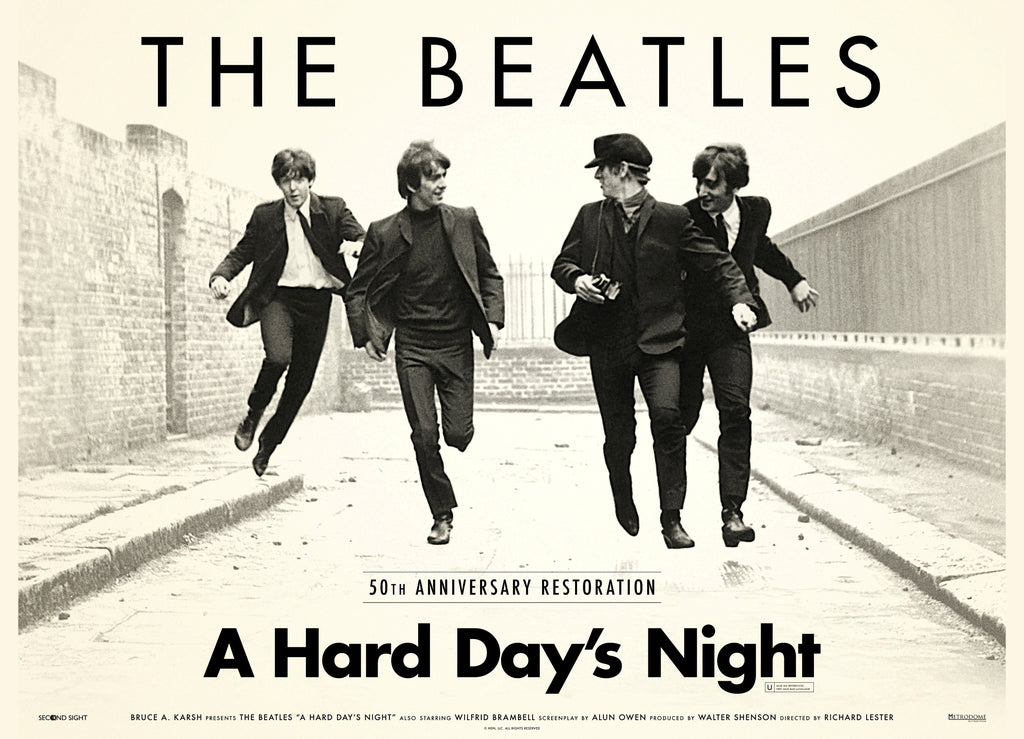
Screen writer Alun Owen had followed the Beatles on tour to understand the impact of their new found fame. His Merseyside background, coupled with director Richard Lester’s previous work with The Goons provided the perfect environment for the Beatles to play out their ‘boy next door’ personas and fast emerging acerbic wit.
The film’s very British, almost slapstick humour, belies the complex thinking that evidently underpins it. The film is careful to build upon the Beatles as a ‘group of individuals’, with each of the fab four given the opportunity to shine in their own right.
Its achievement as anything other than a ‘slapped-together money maker’ is quite remarkable. Brian Epstein had begun discussions on a film in October 1963. Its production, six months later, coincided with one of the busiest periods of The Beatles' career, with filming having to fit around recording of the soundtrack album (which included seven new songs) and numerous other Beatle commitments.
The film's royal charity premiere was held on the 6th July, only four months from the start of filming.
Despite this, the film was a commercial and critical success, winning favourable reviews from all quarters and earning Owen (for Script) and George Martin (for Soundtrack) Oscar nominations.
A Hard Day’s Night took circa £4.5M at the box office, against its relatively meagre budget of £189,000.
Over fifty years later it is still heralded as one of the greatest pop musical films, with TIME magazine (2010) rating it as one of the top 100 films of all time.
Not bad for a first effort.
Help! (1965)
Following their early success in the States, Epstein had negotiated a three movie deal with United Artists.
Beatles 2 was to be a very different film. Whilst The Beatles would, once again, play themselves, in the year since A Hard Day’s Night, their world had changed dramatically. They were no longer ‘the boys next door’. They now lead super-star lives and had (in no small part due to Bob Dylan), discovered some of the narcotic trappings of the trippy ‘60s.
Whereas the down to earth, working-class boys of the previous film had run-from, but enjoyed, their newly found fame, another year of Beatle-mania was starting to wear the group down.
Beatles 2 would therefore be a full-colour fictional fantasy in which the group could escape for the eleven weeks of filming.
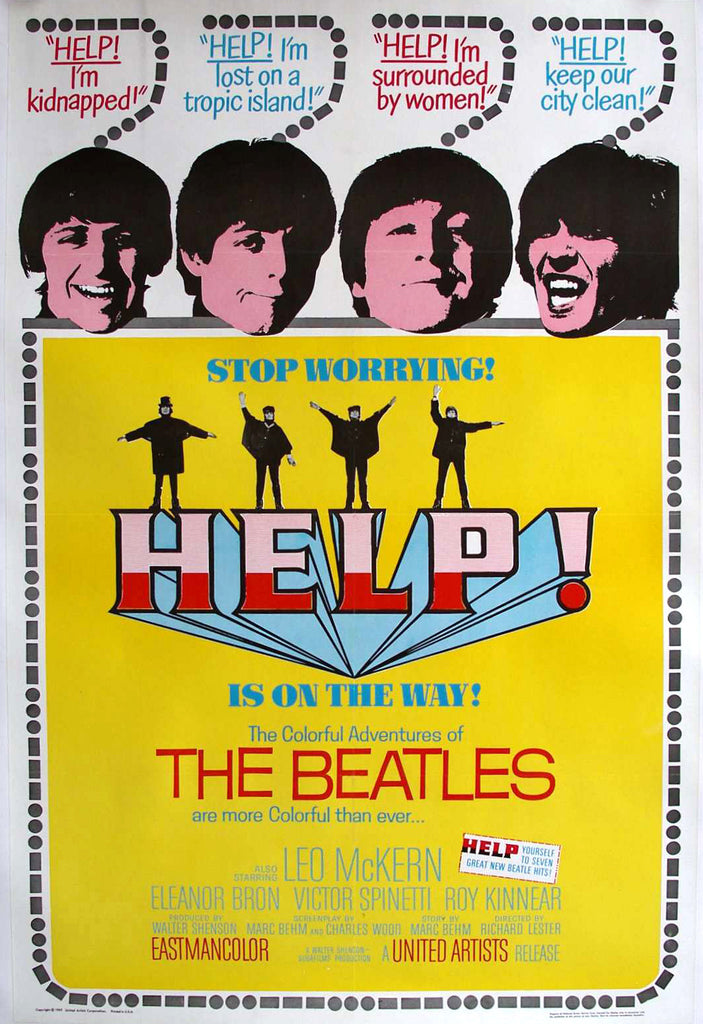
From 23rd February to the 11th May 1965, the fab-four entered a purely fictional world, again directed by Richard Lester, but with a screen play by Marc Behm and Charles Wood. With a humour and satirical tone retained from the first film, they found themselves pursued by a mad scientist and mysterious cult members, all after a ring that appeared to have permanently attached itself to Ringo’s finger. With their seven new songs woven into James Bond pastiches and nods to The Goon Show and The Marx Brothers, this film was a far more ambitious affair.
On 29th June 1965, a little over two months after filming closed, the second Beatles film had its royal world premiere. The film had been through a succession of titles from Beatles 2 to Eight Arms to Hold You to the final Help!. Complete with an exclamation mark to help prevent a potential copyright infringement with another film.
With a budget twice that of A Hard Day’s Night, Help! also returned a similar box-office, of around £4.5M.
Whilst not as strong as for the first film, critical response was also generally positive and it laid a blueprint for countless music videos and TV shows such as The Monkees, which appeared a year later.
A few dead ends, including a potential Three Musketeers film and a racy script from Joe Orton were discussed before the third Beatles film would come to fruition.
Magical Mystery Tour (1967)
In the two years since Help!, the Beatles transformation from clean-cut, Pierre Cardin suit wearing, mop topped boys-next-door to psychedelic, flower-power, counter-culture icons was nearly complete.
For the group, 1967 had been a year of seismic events. The June release of Sergeant Peppers had given the band its greatest commercial and artistic success. The same month they satellite broadcast the peace anthem All You Need is Love around the world. However, in August, only two months later, their manager, mentor and guide Brian Epstein tragically died.
The year would close with the Boxing Day (26th December) broadcast on BBC 1 of The Beatles’ third film, Magical Mystery Tour.
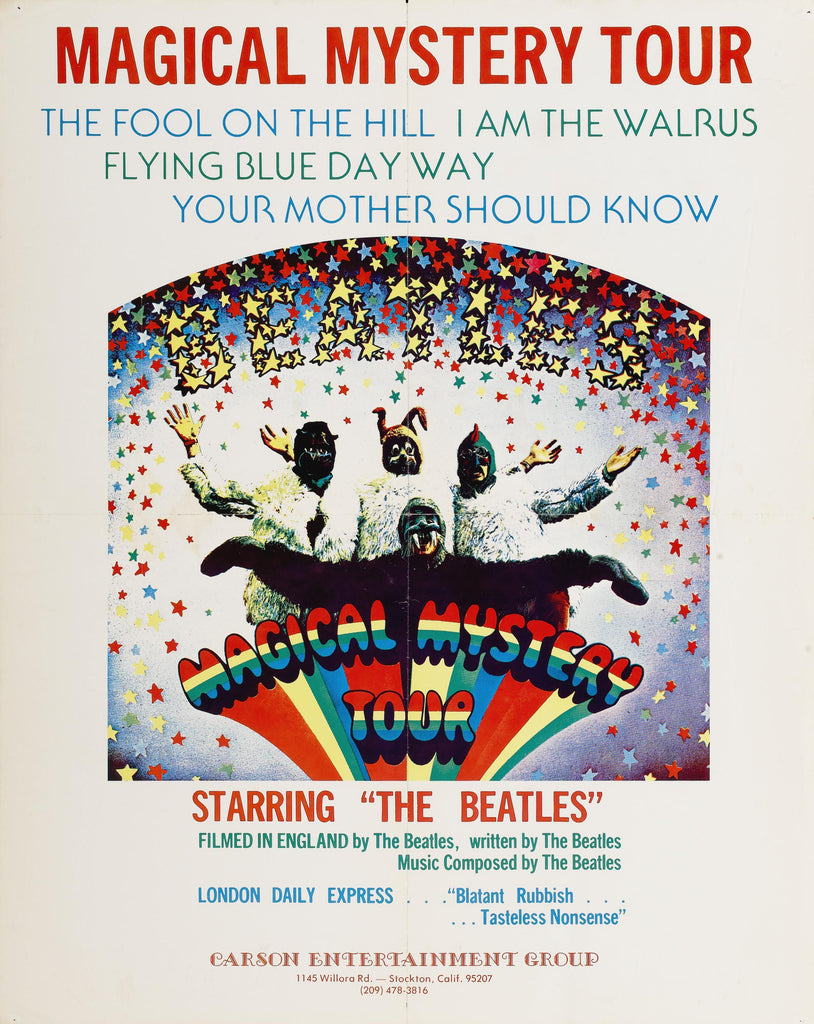
While the film had developed out of a proposal by Paul McCartney, the finished film was the creation of all four members of the band. Produced much as a Beatles album would be, it comprised individual ideas from each member of the band, worked together as a whole, in this case under the premise of a bus tour around England.
Self produced, self directed and self financed, the film had a budget of £30,000 and was filmed over two weeks in September 1967.
The first week involved an actual bus tour around the counties of South West England (pursued by news crews). The second, filming in a Soho revue bar and a hangar in West Malling (beset by screaming fans).
With four directors, it was perhaps unsurprising that editing took eleven weeks to complete.
The result, a deliberately challenging, plot-less, psychedelic and satirical 52 minutes of film.
Broadcast by the BBC at peak-time over Christmas, it drew complaints from the viewing public and bile from critics. Its lucrative release in the U.S. was cancelled and it would not be seen on U.S. television until 1985.
Looking back over fifty years later, Magical Mystery Tour sits at an important juncture in the Beatles timeline. Late 1967 may not have been ready for the transformation of the early Beatles, but the film provides a fascinating, almost ‘home movie’ view, in to their world at that time.
Yellow Submarine (1968)
Unbeknownst to most UK based Beatle fans, the fab-four had been running around in animated form since September 1965. Epstein had struck a deal with cartoonist Al Brodax, whose company 'King Features' then produced circa sixty cartoons starring the group. Shown in the U.S. on ABC, each episode’s title was based on one of the band’s songs.
The original deal promised involvement in a film if the series proved successful. In 1966 (prior to Magical Mystery Tour), talk of the animated film gained momentum and agreement was reached, with four new songs to be penned.
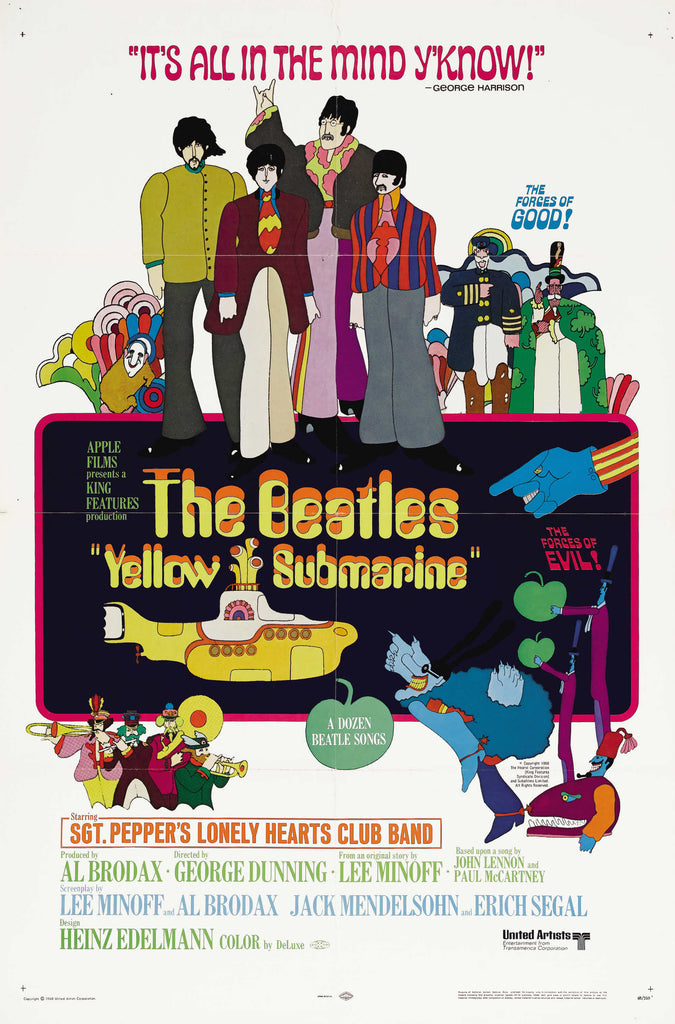
With a budget of $1M (far greater than any Beatles film to date), production of Yellow Submarine began in 1967, directed by George Dunning and involving the work of two hundred animators.
In contrast with the total control The Beatles had exerted over Magical Mystery Tour, for their fourth film, they actually had very little involvement.
The film makers negotiated to bring the group closer to the production, including asking them to voice the animated characters, but, their involvement was limited to the four new songs and an appearance, as themselves, in the final scenes.
The bands apparent lack of enthusiasm for the film was countered by the quality of the psychedelic final output. The Beatles battle with the Blue Meanies to restore order to Pepperland is an animated tour de force that won the admiration of the group.
Released on 17th July 1968, only seven months after Magical Mystery Tour, the film was an immediate critical and box-office success.
Looking back, the film is also far more important than “a good Beatles movie”, it is a very worthy and important piece of cinematic art. Pixar co-founder John Lasseter has apparently credited Yellow Submarine with paving the way for the diverse world of animation that we enjoy today. Josh WeinStein of The Simpsons claims that it "gave birth to modern animation", and (according to a BBC article), it was even rumoured to be one of the late Queen's favourite films.
Let It Be (1970)
What do The Beatles, J.R.R. Tolkien and Stanley Kubrick have in common? Perhaps thankfully, not the version of The Lord of The Rings that The Beatles were interesting in making and that they approached Stanley Kubrick to direct. (Kubrick responded that it was 'unmakeable'.)
The roots of the final Beatles’ film were far more down to earth. The Beatles had decided to return to the music of their early years and to make a pure ‘rock and roll’ record, without the overdubs and studio trickery they had increasingly employed since the album, Revolver.
They would make an album that they could play live and rather than tour it, they would perform it live on a TV special that could be shown around the world. A TV documentary would accompany the special, capturing the creation of the new album.
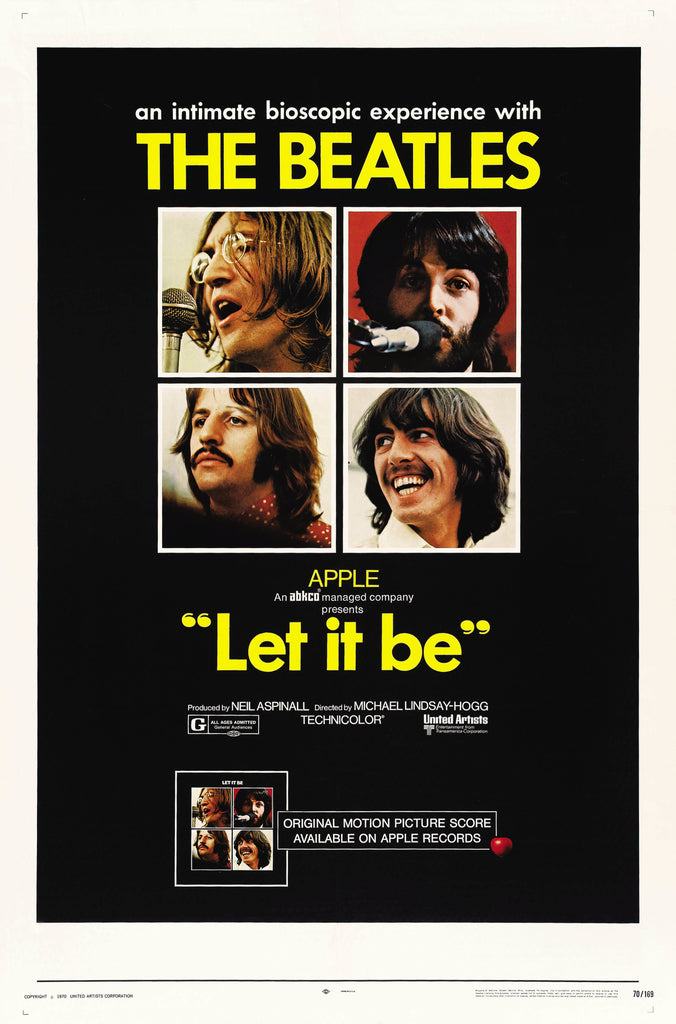
Michael Lindsay-Hogg was hired to film the group at work and to craft a half hour documentary from the resulting footage.
Rehearsals began at Twickenham Film Studios on 2nd January 1969, but the band struggled to work cohesively. George Harrison actually walked out, eventually returning with a list of demands – including that the TV special be dropped, and, that rehearsals were held at Apple’s new HQ in London.
Rehearsals recommenced on the 20th January and on 30th January, the famous concert on Apple’s rooftop at #3 Saville Row took place, much to the disbelief of local office workers and the alarm of the metropolitan police.
Lindsay-Hogg’s final film features three acts – the first of the rehearsals at Twickenham, the second of the rehearsals at Apple, and, the third of the rooftop performance. At times uncomfortable viewing, it shows the cracks and tensions of the ‘four way divorce’, but, also the creative energy of this extraordinary group.
Renamed Let It Be (rather than the original Get Back), the film was eventually released on 13th May 1970, just weeks after the news of The Beatles’ split had become public. None of the group attended the New York premiere.
The film won the Best Original Song Score Oscar, with Quincy Jones accepting the award on the band’s behalf.
The fifth Beatles’ film marked the end of an amazing journey.
Well, not quite...
Fifty years later, Oscar winning director and huge Beatles fan, Peter Jackson, was given access to the Let It Be film tapes. Following a painstaking journey of research and restoration, a three part documentary Get Back, was released in 2021. In addition, the Saville Row rooftop concert was given a very limited IMAX theatrical release. We were lucky enough to go. The closest we will ever come to seeing The Beatles live. We loved it.

Original vintage Beatles posters are highly collectible and add really iconic imagery to any home. You can see what we currently have available here.
We are off to listen to A Day In The Life, a whole movie in 5 minutes 37 seconds of music. (It even has a ‘post-credits' scene.) Amazing.
Remember All You Need Is Love (and an original movie poster). :-)
Adam and the Art of the Movies team.
P.S. If you’d like to know more about the movies of The Beatles, we recommend Bob Neaverson’s book, The Beatles Movies. It is fantastically insightful and was one of the sources for this blog post.



